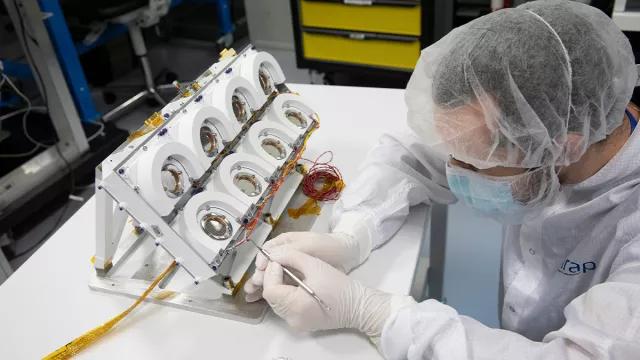There are many processes on the surface of the Moon that we have yet to fathom. But after years studying our natural satellite from orbit, we have now acquired in-situ data with the DORN instrument from the far side of the Moon, riding on China’s Chang’e 6 lander to investigate radon, a radioactive gas continuously emanating from lunar soil.
Key information
| Mission | Measure concentration of radon, a radioactive gas produced on the Moon, and probe the origins of the tenuous lunar “atmosphere” |
|---|---|
| Domain | Science |
| Launch date | 3 May 2024 Moon landing: 2 June 2024 |
| Partners | CNES, CNSA, IRAP, CEA, OMP, Subatech/Arronax, Albedo Technologies |
| Where | Apollo crater in the South Pole-Aitken (SPA) basin on the far side of the Moon |
| Lifetime | Chang’e 6: 1 month, including 48 hrs on the surface of the Moon DORN: 23 hrs on the surface of the Moon plus a few tens of hours acquiring data during the cruise phase and from lunar orbit |
| Status | Completed |
Key figures
- 4.5 kg: mass of DORN instrument
- 48 hrs: duration of experiment on lunar surface
- 2 kg: quantity of samples returned to Earth
- 40 cm²: Alpha particle detection surface on DORN
Key milestones
- 25 June 2024: Samples returned to Earth
- 2 June 2024: Landing on the Moon and surface operations for 48 hrs
- 3 May 2024: Launch by Long March 5 from Wenchang, China
- August 2023: Delivery of DORN instrument to CNSA
Project in brief
In the spring of 2019, the Administrator of CNSA (China National Space Administration) and CEO of CNES (Centre National d’Etudes Spatiales) signed a memorandum of understanding to fly a French payload on the Chang’e 6 lunar mission. DORN was selected by CNES in September of the same year, becoming the first French-Chinese collaboration in the field of planetary exploration, officialized on 6 November 2019 during President Emmanuel Macron’s state visit to China.
The DORN demonstrator, the first French scientific instrument built to operate on the Moon’s surface, is designed to measure radon, a radioactive gas continuously emanating from lunar regolith due to the decay of uranium.
It measured radon concentration on the Moon’s surface for the first time ever to probe the origins of the tenuous “atmosphere” that planetary scientists call the lunar exosphere. To this end, DORN investigated outgassing of radon and its transport in the lunar environment.
DORN will also refine measurements of uranium previously acquired from lunar orbit and yield new insights into the transport of lunar dust, as well as the migration of water molecules to polar craters where they form ice.
The French instrument riding aboard China’s Chang’e-6 spacecraft operated on the far side of the Moon in the South Pole-Aitken basin, an area spanning 2,500 kilometres where no samples had ever been collected before. This is the largest and deepest impact crater on the Moon, and at 10 kilometres deep the region where elevations are lowest and among the locations where the lunar crust is thinnest.
CNES’s role
DORN was designed and built at the IRAP astrophysics and planetology research institute with oversight from CNES. The agency is supporting all of the French research laboratories contributing to the mission.
Contacts
Project Leader
Aurélie Moussi
E-mail: aurelie.moussi at cnes.fr
Solar System Planets and Small Bodies subject matter expert
Francis Rocard
E-mail: francis.rocard at cnes.fr


